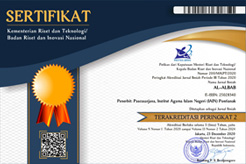BUILDING PLURALIST ATTITUDE IN DOING ISLAMIC EDUCATION AT HIGHT SCHOOL AND MADRASAH
Abstract
Keywords: Instruction of Islamic education, Pluralist attitude, School, Madrasah
Full Text:
PDFReferences
Barth, Fredrik (ed). 1988. Kelompok Etnik dan Batasannya. Jakarta: UI Press..
Departemen Pendidikan Nasional, 2011 Kamus Besar Bahasa Indonesia. Jakarta: Gramedia Pustaka Utama.
Gaus AF, Ahmad. 2006. Kekaisan Nurchalish Madjid dan Dinasti-Dinasti Pluralisme Islam Kontemporer dalam Menembus Batas Tradisi: Menuju Masa Depan yang Membebaskan. Jakarta: Universitas Paramadina dan Kompas.
Salim, Moh. Haitami, 2009. Pluralisme: Suatu Tinjauan Fakta Sosial. Makalah disampaikan pada Seminar Naasional Membincang Pluralisme Perspektif agama, sosial dan budaya, diselenggarakan oleh P3M STAIN Pontianak, pada Sabtu, 16 Mei 2009 di Pontianak. tt.
......................................, 2012 (a). Ikhtiar Membangun Kalimantan Barat yang Maju dan Bermartabat, STAIN Press. Pontianak
..................................., 2012 (b). Mempererat Kerukunan Etnis dan Umat Beragama dalam Tatanan Masyarakat Pluralis-Multikultur di Kalimantan Barat, Bulan Sabit Press-Pontianak
..................................., 2012 (c). Pembauran Bangsa Dengan Penguatan Empat Pilar Kebangsaan Dengan Mensinergikan Peran Tri Pusat Pendidikan, Makalah Diskusi disampaikan dalam Diskusi Pembauran Kebangsaan Pemerintah Kota Pontianak, 31 Oktober 2012. tt.
..................................., dkk. 2012, Mengukuhkan Kerukunan Umat Beragama di Kalimantan Barat. Kerjasama FKUB Kalbar, CAIREU STAIN Pontianak, Kanwil Kementerian Agama Kalbar dan Forum Peduli Ibu Pertiwi (FPIP) Kalbar-Pontianak.
Salim, Moh. Haitami, Eka Hendry, Dulhadi, 2007. Prasangka Antar Kelompok Etnis di Kalimantan Barat. Pontianak: STAIN Press.
Al-Qadrie, Syarief I. 2002. Factors in Ethnic Conflict, Ethnic Edentity and Consciousness, and the Indications of Disintegrative. Dalam Chaedir S. Bamualim dkk. (ed). Communal Conflicts In Contemporary Indonesia. Konrad Adenoauer Stiftung dan Center for Language and Culture. Jakarta.
Taher, Tarmizi, 1998. Menuju Ummatan Wasathan. Jakarta: Pusat Pengkajian Islam dan Masyarakat (PPIM)-IAIN Jakarta.
http://id.wikipedia.org/wiki/Pluralisme, akses 1 Juli 2013
Article Metrics
 Abstract views: 2395
Abstract views: 2395
 PDF views: 1094
PDF views: 1094











